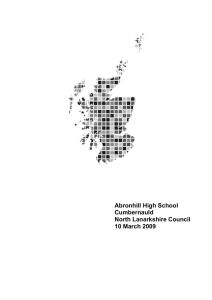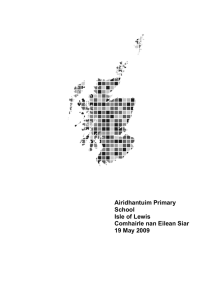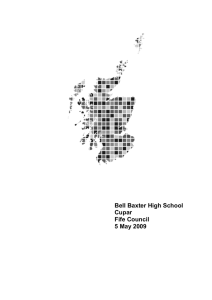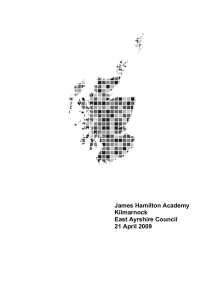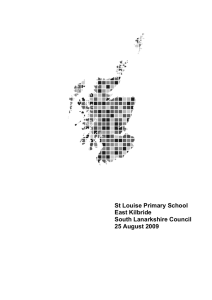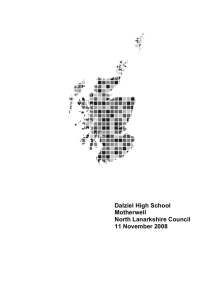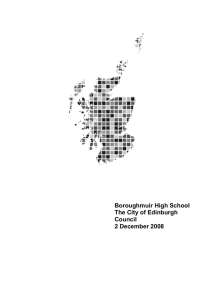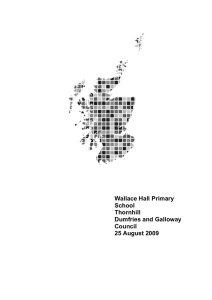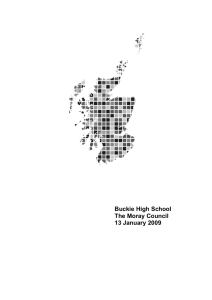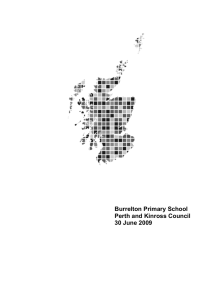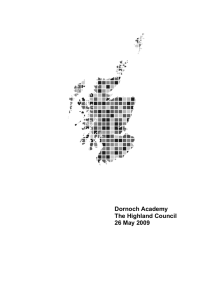St Kessog’s Primary School Balloch
advertisement
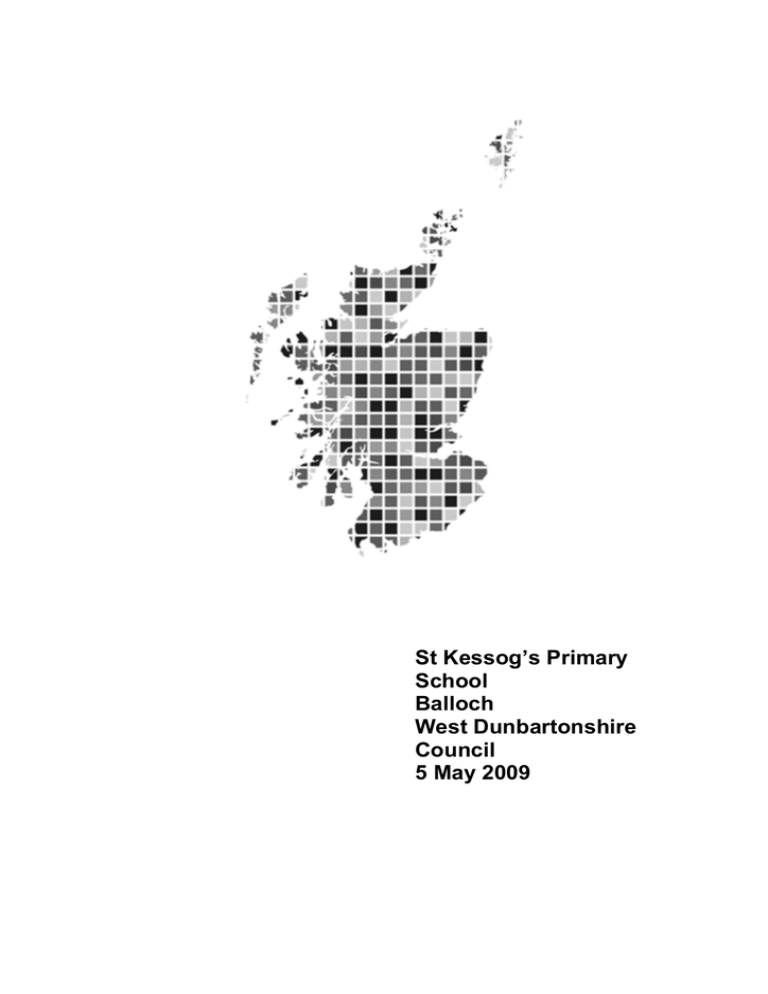
St Kessog’s Primary School Balloch West Dunbartonshire Council 5 May 2009 This report tells you about the quality of education at the school. We describe how children benefit from learning there. We explain how well they are doing and how good the school is at helping them to learn. Then we look at the ways in which the school does this. We describe how well the school works with other groups in the community, including parents1 and services which support children. We also comment on how well staff and children work together and how they go about improving the school. Our report describes the ‘ethos’ of the school. By ‘ethos’ we mean the relationships in the school, how well children are cared for and treated and how much is expected of them in all aspects of school life. Finally, we comment on the school’s aims. In particular, we focus on how well the aims help staff to deliver high quality learning, and the impact of leadership on the school’s success in achieving these aims. If you would like to learn more about our inspection of the school, please visit www.hmie.gov.uk. Here you can find analyses of questionnaire returns. Where applicable, you will also be able to find descriptions of good practice in the school. 1 Throughout this report, the term ‘parents’ should be taken to include foster carers, residential care staff and carers who are relatives or friends. Contents 1. The school 2. Particular strengths of the school 3. Examples of good practice 4. How well do children learn and achieve? 5. How well do staff work with others to support children’s learning? 6. Are staff and children actively involved in improving their school community? 7. Does the school have high expectations of all children? 8. Does the school have a clear sense of direction? 9. What happens next? 1. The school St Kessog’s Primary School is a denominational school. It serves the town of Balloch and the surrounding area of West Dunbartonshire. The roll was 149 when the inspection was carried out in March 2009. Children’s attendance was in line with the national average in 2007/2008. 1 2. Particular strengths of the school • Children’s behaviour, active participation in learning and their contributions to improving the school. • Staff teamwork and commitment to meeting all learners’ needs. • Shared values which permeate the strong community of faith. • Innovative approaches to implementing Curriculum for Excellence. • The visionary leadership of the headteacher. 3. Examples of good practice • Using children’s views to improve learning and teaching through The Pulse • Meeting children’s learning needs using a masterclass approach. • Interdisciplinary approaches to learning. 4. How well do children learn and achieve? Learning and achievement All children are very well motivated and enthusiastic about their learning. They are developing well as successful learners, who are determined to achieve their best. Staff are very committed to creating opportunities to broaden children’s learning and widen their 2 achievements. Children respond wholeheartedly to these learning opportunities. They engage actively in discussions about their targets for learning. Children know how to improve their work and make further progress. Successful initiatives include a whole-school theatre visit, residential excursions, and partnership with Celtic Connections to record children’s learning through their Scottish theme. Children who attend masterclasses in mathematics, information and communications technology (ICT), art, drama, writing and singing use their learning to teach others new skills. Many children increase their self-esteem through sports and musical performances in the local community. Children’s learning experiences are further enhanced through projects in school and outdoors involving the countryside ranger and emergency services staff. The school has maintained consistently high standards of achievement in English language and mathematics over recent years. All children listen attentively to their teachers and to each other during lessons and assemblies. They are developing strong oral skills through regular opportunities to talk in groups, to teach others and to present their work to the whole school. Children enjoy reading and are making very good progress. From P4, almost all children read confidently a variety of different types of books and use a range of resources for research purposes. Staff have been successful in improving the ways children are taught to develop their writing. This has raised attainment in writing significantly over recent years. Across the school, children produce a high standard of written work for a variety of purposes. Children’s progress in mathematics is very good. They confidently apply their developing knowledge of number, money, measurement and shape in a variety of situations. For example, children at P7 used their knowledge of percentages to illustrate their learning about different nationalities living in the USA. Curriculum and meeting learning needs Over recent years, the school has been reviewing and developing the curriculum to take account of the national initiative, Curriculum for Excellence. Staff plan a wide range of learning experiences which 3 children find challenging, enjoyable and relevant. Well-chosen themes very successfully enable children to link their learning across the curriculum. Children increase their understanding of their own culture and values whilst learning about others. Wide-ranging opportunities for out-of-class learning enable children to understand the purpose of their learning and increase their knowledge of the world. Children’s literacy and numeracy skills and their health and wellbeing are being developed well across the curriculum. As part of their work on the Homecoming theme children in P2 produced graphs to show where their relatives had emigrated. Those in P1 increased their understanding of weight and healthy eating through growing potatoes. Children thoroughly enjoy the weekly focus days which enable P1 to P7 to work together with a number of different staff and visitors. Through a wide range of creative and investigative activities, often using ICT, children further explore themes in ways which deepen their learning. Staff are effective in encouraging children to contribute to curriculum development by allowing them to choose some of the themes they will study. Well-structured, additional programmes of work in mathematics, English language and environmental studies, for example, ensure that children’s learning is appropriately consolidated at each stage. Children in P6 and P7 are successful in learning French. All children benefit from two hours of good quality physical education each week, and are enthusiastic about fitness lessons. All children have their learning needs met very effectively. All staff know the strengths and learning needs of the children well. They take very well-judged action, including appropriate differentiation of tasks, to ensure that all children make very good progress. Teachers are skilful in their use of questioning to develop children’s thinking. They provide detailed written and oral feedback which enables all children to improve their work. Staff’s sensitive use of praise encouraged and motivated children. Staff use cooperative learning strategies very effectively to give children responsibility for their learning. Tasks and activities are very well planned to provide high levels of support and challenge for all children. Almost all children are developing well as independent learners. All teachers discuss the purposes and outcomes of lessons with children. Children are developing very well 4 their abilities to set appropriate targets and evaluate their own progress. Learning support staff and classroom assistants are well deployed to provide additional support to individuals and groups as required. All children in P1 benefit from additional learning activities in the Magic Zone which consolidate their early literacy and numeracy development. Children with additional support needs, including those who are gifted and talented, have appropriate targets for learning and personal development. All children have very good opportunities to further extend their learning through attending a masterclass in an aspect of learning which particularly interests them. Targets are agreed and regularly reviewed through discussions involving school staff, appropriate partner agencies, parents and children. 5. How well do staff work with others to support children’s learning? Staff have developed very effective links with a wide range of other organisations to ensure that children’s learning is well supported. This work includes appropriate partnership with the educational psychologist, family and support staff and network support for learning staff. Partner agencies feel well included in decisions about how best to support children. Parents increase their understanding of how to support children’s learning through attending lessons and working with children on interesting homework tasks. A number of parents attended fitness sessions organised by staff. They learned more about the school’s approaches to health and wellbeing. Regular newsletters, detailed reports and meetings with staff keep parents well informed about children’s progress. 5 The school is reviewing its use of home-school learning journals in order to involve parents further in supporting their children’s learning. Parents and local employers shared their experience of work with children as part of the school’s work on enterprise. Parents and partners respond well to the range of opportunities to make comments on aspects of school life. Very good arrangements are in place for supporting children as they move from nursery to P1. The school is working closely with other primary schools and Our Lady and St Patrick’s High School to strengthen the good arrangements for those transferring from P7 to S1. The school responds appropriately to the very few complaints it receives. 6. Are staff and children actively involved in improving their school community? All children respond very well to the many opportunities for them to take responsibility for improving their school. A group of children from P5 to P7, lead a whole school fitness initiative through their enterprise project Sports R Us. Those in P7 act as buddies for children in P1. Through the Pulse initiative children in P4 to P7 effectively lead class discussions about learning. They keep the headteacher and staff well informed about what is working well for them and highlight things which make learning difficult. The school is planning to extend this initiative to include younger children. Class councils involving all children, effectively bring about significant improvements in the learning environment. A recent whole-school conference led by children resolved a number of issues which staff and children had raised. The school is committed to regular fundraising for local and international charities and to supporting a partner school in Africa. These activities contribute to the strong sense of community demonstrated by all staff and children. Staff and children from all stages worked well together to achieve the Eco-Schools Scotland bronze and silver awards. All staff willingly take responsibility for continually improving the school. Working in teams they plan learning experiences in and out of class which children find exciting and challenging. Staff evaluate their own work very effectively and value 6 opportunities to further develop new skills. They lead their own learning and willingly share their expertise with colleagues in the school and beyond. They are very good role models for the children. 7. Does the school have high expectations of all children? Across the school relationships are founded on mutual respect. Staff and children enjoy working together. Children are hugely proud of their school. They present work neatly, behave very well and demonstrate high levels of care and concern for each other. Visiting speakers were very impressed by children’s knowledge of their work and the high quality of questions which children asked. Staff speak highly of all the children in their classes. They recognise and reward children’s achievements very well in class and at whole-school events. Plans are in place to increase children’s involvement in recording and reflecting on their achievements. All staff are well informed about safeguarding procedures and take appropriate steps to ensure children are safe and nurtured. Daily assemblies and regular religious services enable staff and children to celebrate their faith with parents and others in the parish. Together they often reflect on shared values such as justice and compassion. Children are enthusiastic about their school being a place that promotes their health and wellbeing. Learning about health and wellbeing and equality and diversity is strongly embedded within the curriculum. Children learn about these issues within relevant contexts. For example, P7 recently examined the issue of obesity in different countries as part of their global citizenship work. P4/P5 children studying China visited a local Chinese restaurant and wrote about the new and interesting food choices they had experienced. Anti-sectarianism is successfully promoted through religious education and partnership work with local non-denominational schools. 7 8. Does the school have a clear sense of direction? The headteacher, her staff and the children at St Kessog’s Primary School have created a strong learning community. They work very well together and with others. They demonstrate high levels of commitment to continually improving their school. The school has successfully taken significant steps forward with Curriculum for Excellence. Parents and partners fully support the vision, values and faith which underpin the work of the school. Throughout the school community there is a shared understanding of the school’s strengths and areas which could be improved. The headteacher has been in post for eleven years. She inspires her staff. The children, their parents and staff from partner agencies hold her in very high regard. Her energy, creativity and innovative approaches have positively influenced the school. Under her outstanding leadership and with a continued focus on teamwork and improvement, the school will undoubtedly continue to thrive. 9. What happens next? As a result of the very good quality of education provided by the school, we will make no further visits following this inspection. The education authority will inform parents about the school’s progress as part of the authority’s arrangements for reporting to parents on the quality of its schools. We have agreed the following area for improvement with the school and education authority. • Continue to develop the curriculum in line with the principles of Curriculum for Excellence and increase children’s achievements through wide ranging approaches to self-evaluation. 8 Quality indicators help schools and nursery classes, education authorities and inspectors to judge what is good and what needs to be improved in the work of a school and a nursery class. You can find these quality indicators in the HMIE publications How good is our school? and The Child at the Centre. Following the inspection of each school, the Scottish Government gathers evaluations of three important quality indicators to keep track of how well all Scottish schools and nursery classes are doing. Here are the evaluations for St Kessog’s Primary School. Improvements in performance Learners’ experiences Meeting learning needs very good excellent excellent We also evaluated the following aspects of the work of the school. The curriculum Improvement through self-evaluation HM Inspector: Patricia Watson 5 May 2009 9 very good excellent To find out more about inspections or get an electronic copy of this report go to www.hmie.gov.uk. Please contact the Business Management and Communications Team (BMCT) if you wish to enquire about our arrangements for translated or other appropriate versions. If you wish to comment about any of our inspections, contact us at HMIEenquiries@hmie.gsi.gov.uk or alternatively you should write in the first instance to BMCT, HM Inspectorate of Education, Denholm House, Almondvale Business Park, Almondvale Way, Livingston EH54 6GA. Our complaints procedure is available from our website www.hmie.gov.uk or alternatively you can write to our Complaints Manager, at the address above or by telephoning 01506 600259. If you are not satisfied with the action we have taken at the end of our complaints procedure, you can raise your complaint with the Scottish Public Services Ombudsman (SPSO). The SPSO is fully independent and has powers to investigate complaints about Government departments and agencies. You should write to SPSO, Freepost EH641, Edinburgh EH3 0BR. You can also telephone 0800 377 7330, fax 0800 377 7331 or e-mail: ask@spso.org.uk. More information about the Ombudsman’s office can be obtained from the website at www.spso.org.uk. This report uses the following word scale to make clear judgements made by inspectors. excellent very good good satisfactory weak unsatisfactory outstanding, sector leading major strengths important strengths with some areas for improvement strengths just outweigh weaknesses important weaknesses major weaknesses Crown Copyright 2009 HM Inspectorate of Education
